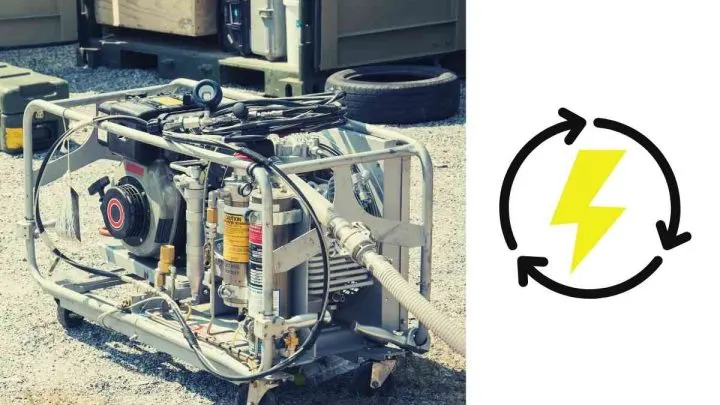Generators are amazing inventions, but they require fuel, whether that fuel be solar, electrical, or gasoline. Just how amazing would it be if a generator could power itself? Sadly, a generator like this isn’t exactly possible, and let’s talk about why.
A generator can’t power itself as it would need an energy source to work correctly since energy losses occur during energy conversion. To supplement these losses and start the device, the generator would need an outside energy source. This, by definition, would make it not self-powered.
In the rest of this article, I’ll give you a little background on how generators work to help you better understand why they can’t be 100% self-sufficient. Next, I’ll tell you in detail why a generator cannot power itself. Lastly, I’ll also write about some generators that are close to being “self-powered” (if you bend the definition a bit).
How Generators Work
A generator works quite simply, but you’ll need some background on electrical generation for me to explain it.
Electricity Generation
According to civil engineer Grady Hillhouse of Practical Engineering on YouTube, energy comes in all different forms. Some energy comes from the sun, some from nuclear power (uranium), some from wind, and some from coal or gasoline.
It’s important to understand that these types of energies are needed to generate power (electricity), as according to the law of thermodynamics, all electricity starts as another form of energy. Basically, this means that you need an outside form of energy to generate power. Energy doesn’t create itself, but it can be converted from one state to another.
One important concept to understand is the conversion of heat energy to rotational energy. This occurs in both home generators and large-scale power plants. The heat energy produced by the energy source helps power a turbine.
Now, in this process, the turbines encounter friction. This friction slows down these turbines a bit, but the energy lost in this process is supplemented (or made up for) by the outside energy source.
If you’re interested in listening to this process explained in a bit more depth, hop over to YouTube to listen to expert Grady Hillhouse:
Generators: How They Create Power
Now that you most likely understand power generation a bit better, let’s discuss precisely how generators work. Essentially, generators work just like any other energy-converting devices (like those discussed earlier); they take one form of energy and convert it to create power.
In most cases, a generator will get energy from an outside source and use that energy to power a rotor, or rotational device. Most home generators will use either gasoline or solar energy as their power source.
The rotational device, which is powered by the energy source, has wires on it. Those wires spin next to a magnet to create a magnetic field. This rotation is used to produce power!
The energy source that you began with transformed into rotational energy. Simply, this process converts one form of energy to power, creating electricity.
One excellent and straightforward video to check out that will give you a visual representation of this process is the below video in which engineer Rudolph Dehn uses a prop to explain energy generation. If you’re interested in watching this quick video, here’s the link:
Why a Generator Cannot Power Itself
As we learned earlier, energy cannot be created from nothing. However, it can be converted as is done in energy generation and generators. This, quite simply, is why a generator cannot power itself.
For a generator to be self-powering, it would need to require no outside energy source. Now, you must question where the energy would come from. If the generator had no energy source, how would it start? How would it continue even if it encountered friction or energy losses?
Well, the imagined self-powered generator couldn’t continue if it encountered energy losses as the energy it puts out would most likely not be enough to make up for these losses, making the generator stop.
To explain this simply, imagine you kick a ball down a flat road. As the ball rolls, it slows as it encounters debris (friction). It initially had energy, but friction made it slow and eventually stop.
Even in a perfect world without friction, a self-powering generator would still need a power source to start it. If a power source were used to power the machine initially, it would no longer be able to be labeled “self-powered.”
In conclusion, according to the first law of thermodynamics, power cannot be created; it needs a source. This law essentially makes a self-powering generator theoretically impossible (source).
Is a Solar Energy Generator Self Powering?
A solar energy generator is not self-powering, but it is self-sustainable. It is not self-powering as the power source (the sun) comes from outside of the generator. The device is often considered self-sustainable as the energy that comes from the sun is renewable and practically infinite.
It might be tempting to call sustainable generators self-powering as they do not require refuels since the energy they use is renewable. In reality, these generators are not self-powering as they utilize an outside power source.
These devices are most likely the closest you’ll get to a self-powering generator as, from the outside, they seem to generate power without much human intervention. However, by definition, these devices are not self-powering. They are self-sustainable, which may somewhat closely resemble your idea of a self-powering device.
Conclusion
A generator cannot power itself as it would need an outside energy source to work correctly as energy losses occur during energy conversion. To supplement these losses, the generator would need an external energy source.
The device would also need a power source to start it, and if one was used, the device could no longer be labeled as “self-powering.”
Recommended Reading

